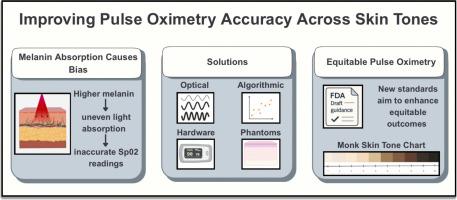Mitigating melanin-induced bias in pulse oximetry: Optical, algorithmic, engineering, hardware and modeling tools
IF 4.9
Q1 CHEMISTRY, ANALYTICAL
引用次数: 0
Abstract
Melanin, the primary determinant of skin pigmentation, absorbs light at wavelengths that can have significant impact on the accuracy of pulse oximetry and other optical biosensing methods. This narrative review examines key factors influencing melanin-dependent pulse oximetry inaccuracies, including optical interference in transmission and reflectance modes. These inaccuracies further highlight the need for use of standardized skin tone metrics in device testing and design such as the Monk Skin Tone scale and Individual Typology Angle for performance stratification. There are several approaches in development that hope to address the errors in pulse oximetry measurements on melanin-rich skin. These include algorithmic and engineering approaches such as multi-wavelength sensing, regression-based correction, and machine learning models demonstrating significant reductions in melanin-induced error. Advances in pulse oximeter hardware and testing are also considered, including tissue-mimicking phantoms, optimized light sources, sensor design, and wearable innovations. Modeling tools, particularly Monte Carlo simulations, are also reviewed for their role in sensor design, spectral optimization, and algorithm training. Finally, evolving regulatory and equity frameworks are discussed, highlighting the January 2025 US FDA guidance on skin tone subgroup reporting. These findings underscore the need for skin-aware calibration and integrated modeling to ensure equitable pulse oximetry performance across diverse populations.

减轻脉搏血氧测量中黑色素引起的偏差:光学,算法,工程,硬件和建模工具
黑色素是皮肤色素沉着的主要决定因素,它吸收波长的光,这对脉搏血氧仪和其他光学生物传感方法的准确性有重大影响。本文综述了影响黑色素依赖性脉搏血氧仪不准确性的关键因素,包括传输和反射模式中的光干扰。这些不准确性进一步强调了在设备测试和设计中使用标准化肤色指标的必要性,如Monk肤色量表和个人类型角度,用于性能分层。有几种方法正在开发中,希望能解决在富含黑色素的皮肤上脉搏血氧仪测量的错误。其中包括算法和工程方法,如多波长传感、基于回归的校正和机器学习模型,这些模型都能显著减少黑色素引起的误差。脉搏血氧仪硬件和测试方面的进展也被考虑在内,包括组织模拟模型、优化光源、传感器设计和可穿戴创新。建模工具,特别是蒙特卡罗模拟,也回顾了它们在传感器设计、光谱优化和算法训练中的作用。最后,讨论了不断发展的监管和公平框架,重点介绍了2025年1月美国FDA关于肤色分组报告的指导意见。这些发现强调了皮肤感知校准和集成建模的必要性,以确保在不同人群中公平的脉搏血氧仪性能。
本文章由计算机程序翻译,如有差异,请以英文原文为准。
求助全文
约1分钟内获得全文
求助全文
来源期刊

Sensing and Bio-Sensing Research
Engineering-Electrical and Electronic Engineering
CiteScore
10.70
自引率
3.80%
发文量
68
审稿时长
87 days
期刊介绍:
Sensing and Bio-Sensing Research is an open access journal dedicated to the research, design, development, and application of bio-sensing and sensing technologies. The editors will accept research papers, reviews, field trials, and validation studies that are of significant relevance. These submissions should describe new concepts, enhance understanding of the field, or offer insights into the practical application, manufacturing, and commercialization of bio-sensing and sensing technologies.
The journal covers a wide range of topics, including sensing principles and mechanisms, new materials development for transducers and recognition components, fabrication technology, and various types of sensors such as optical, electrochemical, mass-sensitive, gas, biosensors, and more. It also includes environmental, process control, and biomedical applications, signal processing, chemometrics, optoelectronic, mechanical, thermal, and magnetic sensors, as well as interface electronics. Additionally, it covers sensor systems and applications, µTAS (Micro Total Analysis Systems), development of solid-state devices for transducing physical signals, and analytical devices incorporating biological materials.
 求助内容:
求助内容: 应助结果提醒方式:
应助结果提醒方式:


